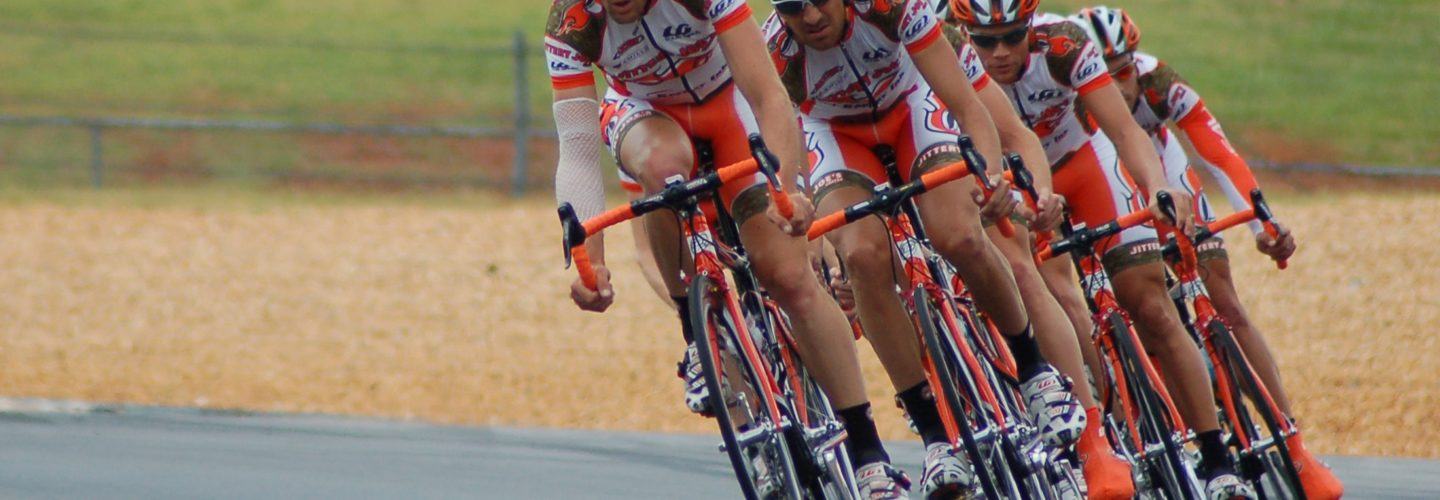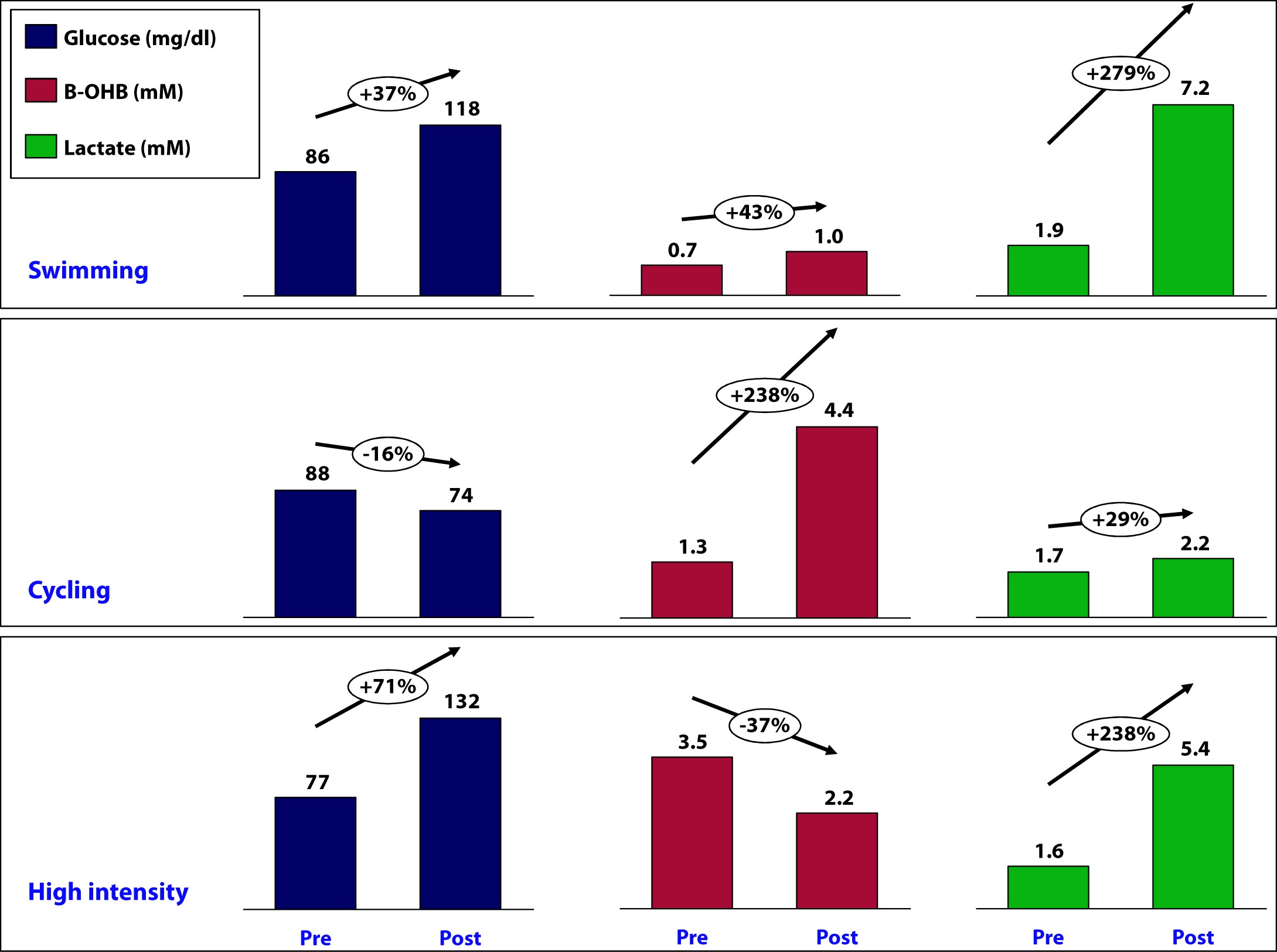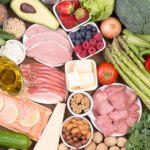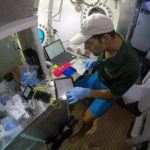I embarked on a self-experiment last weekend to see if I could better understand the interplay between the different types of exercise I do and ketone production (beta-hydroxybutyrate, or B-OHB, to be specific). To be clear, nothing I do with a sample size of one “proves” anything, but sometimes self-experiments can help you formulate hypotheses and, if nothing else, understand how your body works. Consider the parable of the black sheep. If you see even a single black sheep in the field, depending on your field of training, you can draw conclusions:
Three scientists were on a train and had just crossed the border into Scotland. A black sheep was grazing on a hillside. The biologist peered out of the window and said, “Look! Scottish sheep are black!” The chemist said, “No, no. Some Scottish sheep are black.” The physicist, with an irritated tone in his voice, said, “My friends, there is at least one field, containing at least one sheep, of which at least one side is black some of the time.”
My point is, even a self-experiment of one can be good for something.
To test the relationship between exercise and ketosis I decided to examine my blood levels of glucose, B-OHB, and lactate immediately before and after three different types of workouts on three successive days. This interplay is complex and no one knows “everything” about it, including the world’s experts (which I am not pretending to be). I’m going to try to balance a fine line in this post – I want to be rigorous enough to explore the ideas with substance but not too detailed to put you to sleep. I hope I am able to balance these forces adequately.
If any of you are not familiar with the work of Jeff Volek and Steve Phinney, but you are interested in the biochemistry of nutritional ketosis, I recommend getting familiar with their work. The list of people who know more about nutritional ketosis is short.
Let’s take a look at the three parameters I measured in a bit more detail. To give you a sense of what is “normal” here are some guidelines:
Glucose
A normal fasting glucose is generally considered to be between 75 and 100 mg/dL. My mean over the past year has been about 90, but I need to mention two very important caveats:
- On the four occasions I have calibrated my hand-held device with an actual laboratory test, my device seems to run high by about 11 mg/dL, so a measurement of 95 mg/dL on my device is probably closer to 84 mg/dL in reality.
- I carry a genetic trait for a disease called beta-thalassemia. The clinical manifestation of this is that I have much smaller red blood cells than normal (about 65% of normal size). There is some evidence in the literature that this condition prevents some accurate testing of any assay that can interfere with hemoglobin. For example, a test measuring glycosylated hemoglobin suggests I have much more glucose in my blood than is actually measured. In fact, the Glycomark test for mean post-meal glucose level suggested I have an average post-meal glucose level of 190 mg/dL which is obviously not true. In other words, something about my beta-thalassemia seems to interfere with, at the very least, measuring glucose linked to hemoglobin, and possibly measuring glucose in general.
I mention these 2 features to say my glucose levels (unlike B-OHB and lactate which I’ve documented to be very accurate) may be artificially elevated. Here’s the important part, though: the discrepancy seems to be constant, so the increases or decreases seem to be good measurements.
Beta-Hydroxybutyrate (B-OHB)
A normal fasting B-OHB level for a “normal” (i.e., non-ketotic) person is zero. Within a day of fasting, you might expect this number to reach 0.2 to 0.4 mM, and about 1.0 mM within 48 to 72 hours of complete fasting, though this is highly variable among subjects.
If you’ll recall from my discussion of keto-adaptation, the threshold for nutritional ketosis is about 0.5 mM. My normal morning fasting level of B-OHB is usually between 1.0 and 2.0 mM with an arithmetic mean of about 1.4 mM.
Both insulin and glucose (probably by causing the secretion of insulin) suppress ketones. This is why, for example, consuming more than about 50 gm of carbohydrates per day and/or more than about 120-150 gm of protein per day makes it difficult to be in nutritional ketosis – too much insulin secretion.
Lactate
Lactate (or lactic acid) is a byproduct of anaerobic exercise. A normal level is considered to be below 2.2 mM. Basically (I’m oversimplifying a bit), when you exercise in a predominately aerobic capacity, while you do generate lactate your liver is able to match muscle production with clearance via a process called the Cori Cycle (a process in which the liver turns lactate back into glucose).
If you’ve ever done a very intense exercise – like run an all-out mile – and felt like your body is completely seizing up and you are unable to move, you’ve experienced a high lactate. Technically, the lactate is not causing this. Lactate gets a pretty bad rap, and it’s actually a good thing as it allows us to generate energy even when we demand it in an environment where sufficient cellular oxygen is absent. The real “bad guy” is the hydrogen ion that accompanies lactate and interferes with the ability of our muscles to contract and relax properly. However, we use lactate as a proxy for the hydrogen that is actually causing the pain and difficulty in muscle contraction.
For me (personally, though this is probably true for most people) the highest lactate I generate tends to be in all-out activities lasting about 2 minutes which use all muscles in my body (the more muscles you use, the more lactate you generate). Hence, the 200 individual medley (IM) race generates the most lactate in my body: It’s 2-plus minutes of maximum exertion sending pain into every muscle in my body (this event requires a swim, in order, of 50 yards each of all-out butterfly, then backstroke, then breaststroke, then freestyle). A runner would probably concur that the 800 meter (half-mile) run is one of the most painful races in that sport.
The highest lactate I have ever measured in myself, following a 200 IM race, was about 16 mM. I have measured higher levels in several Olympic swimmers, including 20.2 mM in one (as he was vomiting all over the pool deck – for reasons I’ll try to remember to explain in a subsequent post). On my bike, where I’m mostly using my legs, obviously, I think my highest recorded lactate measurement was about 12 or 13 mM following a set of ten 2-minute all-out hill repeats.
I measure my lactate levels using a different hand-held device from the one that measures glucose and B-OHB.
[Another parable, this time about marriage: 2 years ago my father asked me what my wife and I wanted for Christmas. I said “we” wanted a lactate meter with about 200 test strips (I think it was about $900 for everything). He looked at me funny, but figured I knew what I was talking about. When Christmas rolled around and “we” got “our” lactate meter I had to spend a few minutes explaining to my wife why this was a perfect gift for “us” as it allowed “us” to spend lots of time together while she pricked my finger for blood during my workouts. She didn’t really agree with me. I clearly don’t understand women very well – I really thought she would find this device “cool.” Which is why this is a blog about health, not marriage.]
Results from my experiment
Day 1: Saturday (hard swim workout, race pace)
This was a one hour, 45 minute swim with warm-up and cool down. The “main set” was mostly freestyle and butterfly at all-out race pace for distances of 25, 50, 75, and 100 yard intervals with long rest (1:2 – 2 times more rest than swim time) for the all-out 100 yard swims, and modest rest (2:1 – half the rest time of each swim). The single most demanding aspect of this workout took place with about 25 minutes remaining and, though I didn’t measure peak lactate, I suspect it was around 12-14 mM, based on the discomfort I experienced. I was surprised that my lactate level was still as high as it was (see below) 25 minutes later, though I suspect I didn’t cool down as gingerly as I should have, to optimize for maximum lactate clearance.
During this workout I consumed nothing and prior to the workout I consumed my usual 40 mL of medium chain triglyceride (MCT) oil.
At 7:29 am, just before beginning the workout, my glucose was 86 mg/dL, B-OHB was 0.7 mM (which is low for my fasting level), and lactate was 1.9 mM.
Immediately post-workout, at 9:14 am, my glucose was 118 mg/dL, B-OHB was 1.0 mM, and lactate was 7.2 mM.
Day 2: Sunday (long ride, 80% of race pace)
This was a tempo ride covering 104 miles (167 km) with 5,600 feet of climbing. Average pace was 17 mph (about 28 km/hr) with lots of headwind. My average HR over this 6 hour ride was 141 and average power output was between 190 and 200 watts. There were many sections of the ride, particularly on the climbs, where my HR was sustained in the 160’s for 30 minute stretches and power output was above 275 watts (which, for me, means my muscles generate lactate faster than my liver can clear it).
During this workout I consumed the following:
- Two single-serving packets (1 oz) of cream cheese (14 gm fat; 2 gm carb; 2 gm protein)
- 50 gm of super starch, by Generation UCAN mixed in my water bottles (50 gm super starch which, technically, is a carb but does not behave like one with respect to insulin secretion and ketone suppression – I will write a dedicated post on super starch in the future, but if you must try it now, use this code to get a discount: “UCANPA”)
- 2.5 oz of mixed nuts (25% of each almonds, cashews, walnuts, peanuts – 36 gm fat; 14 gm protein; 15 gm carb)
Total intake during 6 hour ride, therefore, was: 50 gm fat; 16 gm protein; 67 gm carb (of which 50 gm was super-starch), for a total of about 750 calories.
About 90 minutes prior to the ride I consumed 4 eggs fluffed with heavy cream, cream cheese, coffee with heavy cream, and my usual 40 mL of MCT oil.
At 7:56 am, my glucose was 88 mg/dL, B-OHB was 1.3 mM, and lactate was 1.7 mM.
Immediately post-ride, at 2:39 pm, my glucose was 74 mg/dL, B-OHB was 4.4 mM, and lactate was 2.2 mM.
Day 3: Monday (dry-land, high intensity training)
On this particular day, it was raining (one of 3 days a year this happens in San Diego), so I did not do the outdoor stuff (including tire flips).
Prior to the workout I consumed nothing other than my usual 40 mL of MCT oil and during the workout I consumed about 4 gm of branched chain amino acids (BCAA) and 10 gm of super starch mixed in my water bottle – so essentially just water.
Immediately prior to the workout, at 6:43 am, my glucose was 77 mg/dL, B-OHB was 3.5 mM*, and lactate was 1.6 mM.
At 7:52 am glucose was 132 mg/dL, B-OHB was 2.2 mM, and lactate was 5.4 mM.
*If you’re wondering why my fasting B-OHB level was so high (recall, I’m usually between 1.0 and 2.0), I suspect it’s at least a partial result of 2 things:
- Residual fat breakdown from the previous day’s long ride and caloric deficit, and
- On Sunday night I ate (no exaggeration) about half a gallon of my wife’s famous zero sugar, high fat coffee ice cream, which must be the closest thing I’ve ever experienced to heroin in terms of addiction potential.
Summary
The figure below summarizes the data from the mini-self-experiment I just described.
What can we learn about the interaction between glucose, B-OHB, and lactate?
How does super starch impact my ketosis?
Is ketosis helping me or hurting me?
Stay tuned for next week, when I will try to interpret these results…
Photo by James Thomas on Unsplash







Although a lot of your science was over my head,
I enjoyed the read and especially the personal antidotes. It was interesting seeing the differences in the graphs due to the difference in activity. I really didn’t expect there to be so much difference. Looking forward to reading part two!
Can you suggest a resource for finding a doctor who is on board with these concepts (Los Angeles area)?
Check Jimmy Moore’s website. He has a list of low carb docs around the country.
Hi Peter,
I noticed this list contains a lot of Chiros and Naturos who call themselves doctors. That perhaps unintended endorsement from you seems to conflict with everything I’ve observed about you and Gary Taubes. You have both demonstrated a highly ethical and critical approach to science and in so doing, I think, advanced the cause of a critical approach to human nutrition.
If the above two categories of “doctors,” bring any science to the table can you explain?
Thanks,
Robert I
I’m not advocating for anyone I don’t know. I’m pointing out a resource to consider. But to your point, why does having an MD or a PhD matter? Am I only credible because I do? Is Dean Ornish “right” because he has and MD? Is Gary not credible because he has neither an MD nor a PhD? Same question for Mark Sisson, Robb Wolf, and many others?
Don’t judge a person by their degrees or lack of degrees. Judge them by what they know and what practice.
I’d love to know which doctor Mark Sisson goes to- he lives in Malibu. Wonder if he’d share that info- guessing Peter doesn’t have that insider info? I was surprised when checking Jimmy’s site, how few docs there were. I’m thinking of going to the cute guy in Woodland hills 😉
Doc
you are an absolutely amazing.
Its great reading your blog and love your spirit.
Peter – forget all the data questions (ketosis, lactate, blah, blah, blah). The bigger question is – how do you get enough money in the wife bank to ride a century on any given Sunday? 😉 Seriously though, how do you find so much time to exercise? Will you give us a week in your exercise life?
Also – thanks for the recommendation on Superstarch. I felt incredibly strong on the bike this weekend with Generation UCAN on board. Also, Xylitol is sweet! Bought a five pound bag and can’t tell the difference between it and sugar. 🙂
Scott, you’ve stumbled on my secret in life (and this goes for all you single guys out there!) — marry a women with low expectations! I was so luck to marry my absolutely wonderful wife (if there were a Wife Olympics, she’d be the equivalent of Michael Phelps) while working 114 hours per week in residency. She expected little more than a pulse. I’m actually so lucky that she not only tolerates my antics, but supports them, despite her own amazing antics (my wife is 10 times the athlete I am and still manages her own training schedule, job, etc). Back when I was mostly training for marathon swimming, she would actually kayak for 8 hours for me on training swims!
Lol. If you tell me you’re having sex twice a day I’ll slit my wrists now . . .
Very interesting, informative and entertaining stuff, Peter. Thanks for sharing. I was struggling with what to fuel with on long workouts, and you’ve given me some great ideas to try. I’ll give the super starch a try. I was just looking over their website and something struck me. In the comparison of super starch to regular starch to maltodextrin, one can see how super starch is superior to maltodextrin, in terms of muting a glycemic spike, but what also stood out for me was that it was only marginally better (13%) than regular old corn starch. I see uncooked corn starch has a molecular weight of about 250,000 and super starch of 500,000 – 700,000. So I guess that raises the question: would using regular uncooked corn starch as an energy drink also be better than using a maltodextrin based energy drink?
It’s a great point. If you read the history of treating of kids with glycogen storage disease (GSD — the disease for which super starch was actually developed), you’ll note that prior to super starch the “gold standard” for treating GSD was actually using argo starch. So yes, I think argo starch would be better than maltodextrin.
You might want to edit the blog post and put the recipe in bold, large font, and a different color! I will be trying it out this weekend or next.
Peter,
Great article again and looking up to the follow up article. I’ve been doing crossfit for over a year now. At my gym, we mostly do high intensity barbell lifting, heavy barbell lifting and some sprinting. I had never had a problem with stamina on the high carb diet. Once I was in shape and I was usually one of the first people done with the workouts. About 3 months ago I decided to try the low carb diet to lose weight and improve my health. I’ve been consistently under 50gm carbs for the 3 months with around 5 days that I went over that amount. On the low carb diet, I usually get tired easily when working out and now I am usually the last person done with the timed workouts. I drink a whey protein drink (mixed in water) and take fish oil. I just bought the super starch today to give it a try. Another thing, which is probably tied to being tired, I’m not as driven to go workout as I used to be. Conversely, I have lost about 15lbs and my cholesterol and blood pressure have dropped since eating this way. Any suggestions on how to not be so tired when working out? On an unrestricted carb diet I was never tired like I am now. Thanks, Mark
Hmmm, could be a number of factors, including just adaptation. It took me MONTHS to adjust to ketosis. I wonder what would happen if you tried some experiments? MCT supplements, CLA? Creatine? Tough to troubleshoot over blog.
Hey Peter –
Curious if there is any particular reason you consume the cheese or nuts on your long rides. Personal preference? Hunger? Technically you wouldn’t be “bonking”, correct? In theory you have an “unlimited” amount of stored energy? I guess what I’m getting at is, nutritional normal ketosis ranges from about point something mm to about 5mm –correct. An unhealthy level would occur at around anything above 15mm or so? -based on Phinney and Voker.?As you go longer, all things equal, with no food, etc, wouldn’t the ketone level rise? So given the longer duration of the ride are you just ensuring that you staying at a safe level? Or is that not what happens (ketones rising during activity)? Best bet to consume something during a long distance event?
Curious as I do endurance events, recently completed ½ marathon and a full marathon. Times weren’t special, the only thing consumed before the event was a lot of chicken broth –maybe 4000 mg sodium. Wanted to consume bcaa during, but forgot bottle, ended up after the event. During the run, I was feeling pretty good. Unfortunately, I didn’t test my ketone levels afterward.
Doesn’t seem to be a ton of research out there on endurance events and ketosis – so I can appreciate your self experimentation.
Great question, Tim. You’re technically correct. I don’t need to eat to prevent bonking, unless you believe I need a tiny bit of oxaloacetate to run the Crebs Cycle (this is a debatable point, though I don’t think so). Maybe it’s just “habit.” I do think the tiny amounts of protein (from the nuts) probably help with delaying muscle breakdown. As far as keeping B-OHB below, say, 15, my pancreas actually takes care of it. As B-OHB levels rise, insulin gets secreted and this sort of acts in a feedback loop to keep ’em in check.
Peter,
Thank you so much for taking the time to do this testing. I found it fascinating. I think one of the most surprising results was that you did 100 miles with that kind of climbing and only consumed 120/calories an hour and never bonked. Definitely encouraging as it seems to prove that your body is able to make glucose from fat.
I had a question … I have been borderline hypertensive before unsurprisingly (140/88) and have real concerns about adding that much salt even though I’m now below 20g of carbs a day. I’m going to see my doctor tomorrow because my BP has been high for three days around 150/90 (I just finished my first week in ketosis today). I’m normally taking in 1500mg of sodium a day.
I’m just not sure what to do. I don’t want to intake bunch of sodium and have that lead to worse hypertension. I’m drinking 3-4 liters of water a day as well.
I just don’t know what to tell my doctor tomorrow.
Thanks for the great website!
One quick correction…my body doesn’t technically make glucose out of fat, it makes ketones, which my brain actually prefers to glucose, hence the reason I don’t bonk. There are lots of reasons for hypertension, so make sure you doctor is looking for them (well beyond what is called “essential hypertension”). In your case, I’d be curious to see what would happen to your BP if you did not, at least temporarily, supplement with sodium.
So my BP when I arrived at 9:30 was 177/90 and had a “slightly” irregular HB according to the EKG they did. By the end of the visit I was back to 140/90.
They did bloodwork to check for sodium, potassium, etc too … I’ll be interested to see where the results end up.
Thanks for responding. I’m hoping the bloodwork gives me targets for the magnesium/potassium/sodium levels I need to supplement so I don’t exacerbate my HBP.
Of late, in the paleo/primal blogosphere (particularly “Free the Animal”) there’s been a lot of stuff about food reward/palatability/satiety as the cause(s) of the obesity/type II diabetes epidemics as opposed to over consumption of carbs. I’m a low carber, 40 pounds gone so far, but I guess this planted a seed of doubt. I just discovered your terrific blog, through Dr. Eades, and feel reenergized. I’d love to get your take on this. Thank you, Sir.
I think there may be something to this idea, for sure, but there are lots of things this idea does NOT explain. Hence, I would think of this not as the “first-order” term. These are testable hypotheses, though, so I hope the scientific community can start to agree on testing versus just arguing and re-stating.
Hi Peter,
I’m just beginning a ketosis diet for the past week. I’ve been thinking about this very question, how do I perform endurance exercise with few carbs? Timely post!
You mention you use Generation UCAN on your rides. Do you use the variety that includes protein or the one without? Do I need protein on my rides or will it interfere to utilize fat for energy? Thanks for your help.
David
I use the super starch only, not the chocolate or vanilla flavors with protein, but that’s just because I don’t like sweet things when I’m exercising, so I mostly consume the flavorless super starch.
Hi Peter,
What’s your wife’s ice cream recipe? (Just kidding! But I will try that this summer. It looks pretty darn good.)
For reference, do you have any idea what your average glucose levels were prior to carb reduction? You say your mean has been 90 or so for the past year, with noted caveats about potential issues with the readings. Did you get any sort baseline prior to shifting your diet?
I’m interested to read your analysis next week.
See previous responses for recipe. Mean fasting glucose before carb restriction was about 15 higher. A1C probably 1.5 to 2.0 higher, but hard to be sure because of beta-thal.
Your wife’s famous zero sugar, high fat coffee ice cream: any chance of providing the recipe? Sounds delicious!
Already done. Check previous comment on this post.
Slightly off-topic, but I thought you’d appreciate this…very satisfying:
https://www.sott.net/articles/show/242516-Heart-Surgeon-Speaks-Out-On-What-Really-Causes-Heart-Disease
I wonder how long it will take for the conventional wisdom to topple. Things seem to really be picking up speed since GCBC/WWGF, and I think your website is contributing a huge amount as well. Excellent work.
I’ve read some great stuff from Dr. Lundell. It will “only” take about 20% of docs getting to this point before we can start to appreciate a real tipping point. Thanks for sharing.
Peter,
If you talk about 2 gr of additional sodium do you mean 2 gr of salt or 2 gr of sodium (which is higher since salt is only 40% or so sodium).
Paul
I take 2 to 4 gm of supplemental sodium (which is roughly 5 to 10 gm of bouillon).
I’ve been fairly low carb eating for several years now (since reading Taubes’ Good Calories, Bad Calories), but not rigorous by any means. The last few weeks I’ve cut a few more carbs and gone to a high fat chocolate coconut milk smoothy for breakfast (I start looking forward to it before I fall asleep) and on some days I get mildly nauseated by lunch time. Today I tried a urine ketone test and was positive when I felt queasy. I drank some salt water and felt better within an hour. I ate a fatty lunch to continue the experiment and stayed ketotic until dinner and felt fine.
I just ordered Phinney and Volek’s book since I’ve seen you recommend it to others when they ask about going ketotic, and how to manage it.
At this time I don’t have any grand design to go into full blown nutritional ketosis, but it has me thinking… are there any potential metabolic problems with “living on the edge” so to speak? I have yet to read/experience any generally dietary regime that I find half so compelling as the primal/paleo/low carb thing, and I can easily rationalize a “back in the day” scenario where our ancestors slipped into and out of varying levels of ketosis daily, weekly, or monthly depending on the season and what type of food was available. But I also recognize that this is mostly my personal bias speaking and not based on much direct evidence.
It requires a bit more thinking to eat like this, mainly because the food infrastructure around us doesn’t support it, but it’s no different that learning a new skill. At first it requires great conscious effort, but over time it becomes more autonomic.
Outstanding once again Peter.
Another great post Peter. Keep it up!
Hi Peter,
I have to say…this particular blog is hilarious 🙂 You have the patience of a saint, lol! Between repeated bullion questions and increasingly militant demands for the secret ice cream recipe, you have had your patience tried…and we’re not even family! This is a lesson to us all to read the blog from the begining before asking something 🙂 Thank you for all of your patience and for taking so much of your time to teach us… you’re super!
God bless,maryann
Thank you! I hope folks can keep this in mind…
Mrs. Attia is the woman who started it all when she encouraged you to be “a little less not thin”. You have a great wife, and she’s talented just like you, too!
From the number of requests for the recipe it looks like your wife’s sugar free ice cream deserves a post of its own!